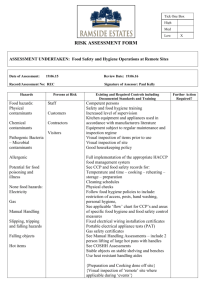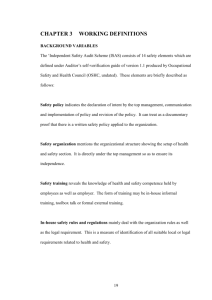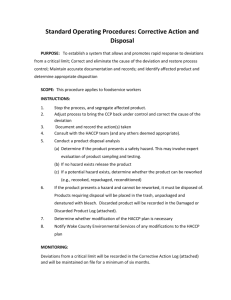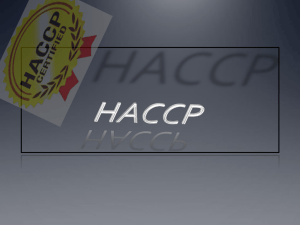ANIMAL BEHAVIOUR ABG 503 2 Units
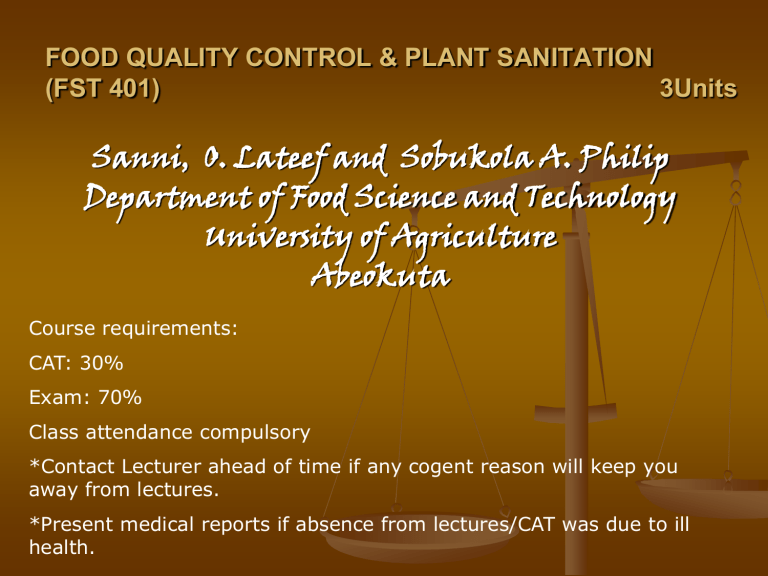
FOOD QUALITY CONTROL & PLANT SANITATION
(FST 401) 3Units
Sanni, O. Lateef and Sobukola A. Philip
Department of Food Science and Technology
University of Agriculture
Abeokuta
Course requirements:
CAT: 30%
Exam: 70%
Class attendance compulsory
*Contact Lecturer ahead of time if any cogent reason will keep you away from lectures.
*Present medical reports if absence from lectures/CAT was due to ill health.
Aims of the course
To understand the general concepts that govern quality in terms of:
Historical background and definitions; scope; significance, meaning of quality and control. Quality in relation to reliability, price, delivery, accounting, purchasing.
To present case studies of organization of quality control in typical food companies, setting specifications for microbiology, chemical and entomological standards.
To achieve competence in the skills on statistical quality control – types of errors and decision making; control charts for variables and attributes – construction and uses; sampling plans, sensory quality control – assessment scores and interpretation of data.
To have information on the codex Alimentarius legislation and codes of practice. Biological and aesthetic problems of poor plant sanitation, waste and affluent disposal; plant design, installation and operation for cleaning purposes; disinfection, sterilization and detergency in processing area; cleaning by dismantling; cleaning-inplace technology, personal hygiene in the food factory.
Quality
A DISTINCTIVE ELEMENT
A LEVEL OF SUPERIORITY THAT IS
USUALLY HIGH
DEGREE OF EXCELLENCE
HIGH STYLE IN QUALITY, MANNER
OR DRESS
PEOPLE OF THE HIGHEST SOCIAL
LEVEL
Assurance
A FIRM BELIEF IN ONE’S OWN
POWER
A STATEMENT THAT EXPRESSES A
COMMITMENT ON THE PART OF
ITS MAKER AS TO ITS
TRUTHFULNESS
THE QUALITY OR STATE OF BEING
SAFE
Quality Assurance - Why & How ?
Definition - Set of measures to ensure defective products are not generated
- Ensures process design consistently meets requirements
Elements – buying specification; raw materials control; on-line process control; finished product inspection; sensory testing
Strategies- 1) Quality Policy – foundation stone for influencing GMP, staff attitudes, sales and profitability
2) Management Reviews
3) Establish Standards for sampling and examination
4) Develop appropriate testing/analysis procedures e.g. SPC
5) Establish and adhere to internal quality standards- AQL
6) Customer complaints handling
7) Recording & Reporting
8) Packaging control
9) Storage & Distribution Controls
10) Continuous Improvement (Six Sigma vs Cost )
Total Quality Management for all-employee involvement sustainable improvement
Challenges – Examples and Case Studies
Quality Awareness
WHO ARE MY CLIENTS
WHAT DO THEY WANT FROM ME
WHAT IS THE BEST POSSIBLE WAYS TO FULFIL
THEIR WANTS
DO I HAVE THE MWANS TO SATISFY THEM
HOW CAN I OBTAIN THE MEANS TO SATISFY
THEM
WHO ARE SUPPLIERS
DO I MAKE THE RIGHT AGREEMENT WITH MY
SUPPLIERS ABOUT WHAT THEY DELIVER
Quality System
System in Operation
STANDARDS
QUALITY MANUAL, PROCEDURES,
WORK INSTRUCTIONS ,
DOCUMENTATION
RECORDS
COMMITTED PEOPLE
OPERATIONS
Quality Beliefs
DO IT RIGHT THE FRIST TIME, EVERY TIME
QUALITY COST MONEY, NON-QUALITY IS MUCH
EXPENSIVE
IF YOU CANNOT SMILE, DO NOT OPEN A SHOP
QUALITY MANAGEMENT AIMS AT SATISFYING
MORE EXTERNAL CUSTOMERS WHILE LOWERING
THE INTERNAL COSTS
QUALITY IS WHAT CUSTOMERS GET OUT OF THE
PRODUCT ANDNOT WHAT SUPPLIER PUT IN THE
PRODUCT
Quality Requirements for Sustainable Improvement
Good Quality Staff : Analytical; of High integrity; trainable; team-oriented
Statistical Tools : sampling plans; process optimization; AQL
Environmental Hygiene & Food Safety : Self-enforcement; HACCP as vital management tool
Building Design & Equipment Layout : location; access; good ventilation; no cluttering; fly-proof meshes; conveniences; water, waste, dust controls; aesthetics
Operator Hygiene & Cleaning Schedule: PPE; training 7 use of posters; cleaning schedule; risk assessment
Regulatory Control : national food standards; standard operating procedures for all areas; internal specifications; etc
Total Quality Management
TQM system are :
Commitment to TQM by all staff including owners/Directors.
The prevention of problems.
To develop a written system that can be followed easily and modified when found necessary.
To train all staff for their role in the system.
To ensure full compliance with the system.
Requirements of TQM
For successful implementation of TQM there are four essential requirements:
Management Commitment
Employee Commitment and Teamwork
Customer Orientation
Quality System.
Examples of Poor TQM Compliance in Manufacturing
Operations/Processes
Technical: Poor documentation or absence of records; delays in inspection time or missed audit schedules; high level of defectives; customer complaints; inadequate process/product specifications; product recall
Sales and Marketing: Lost opportunities due to poor forecasts or lack of initiatives; Blocked pipelines due to wrong forecasts; Excess or Obsolete Stocks returned from trade; fall in market share; Unambitious Targets; Low profitability
Engineering: High Operational Down-times and Production losses;
Breakdown maintenance; Poor/Inadequate knowledge and/or training leading to wastage of spares; use of wrong spares; avoidable injuries due to cutting corners
Examples of Poor TQM Compliance in
Manufacturing Operations/Processes
Personnel: Non-implementation of appraisal returns/recommendations; delays in filling vacancies; High staff turnover; Industrial disputes; unwarranted injuries
Logistics: Materials Stock-Out; Poor Quality Deliveries; High prices; untimely deliveries; poor documentation and/or recordkeeping
Finance: High receivables; payment delays; irregular/inaccurate stock counts; poor budget forecasting
SPECIFICATIONS
The cornerstone of quality assurance and quality control system is the specification.
It embodies the control limits – the minimum or maximum values of the various chemical, physical, physico-chemical properties of raw and packaging materials and manufactured products.
It is aimed at: minimum rejects, maintenance of uniformity, increase consumer’s satisfaction and minimized cost of production.
Quality attributes for tomatoes
Attribute
Colour
Size
Shape
Damage
Splitting
Insect
-mould
Hardness
Accept
Orange/red
Any
Any
<5%
< 5%
None
Soft to over soft
-
Reject
-
More than 10% green
>5%
>5%
Any evidence of mould
More than 10% hard
Type of Specification
Raw Material Specification: Here the choice of raw materials is determined in the early stages of research and product development e.g. cocoa powder for chocolate drink. At such stage, the important properties of the raw material like geometric (shape, size, surface area), physical, color, appearance, aerodynamics and hydrodynamics and functional properties are determined and designated based on existing standards.
Finished Product Specification: Like the raw material specification, the finished product specification is a direct consequence of manufacturing formula/recipe and orignates from the research and development work on the product. It describes the chemical, physical, physico-chemical and bacteriological properties of the final product.
FOOD STANDARDS
They could be defined as a body or rules that concerns foods right from ingredient assembly to finished products or retail presentation.
It is an integral components of food laws.
Standards are varied in character, subject and medium.
For the economic players, the standard is:
A factor for rationalization of production
A factor for clarification of transactions
A factor for transferal of new technologies
A factor for strategic choice for companies
Classification of Standards
Standards have been classified as follows:
In respect of the object standardized as definition, designation, composition, additives, quality level of products, hygiene, pesticide residue, packaging, marking/labeling, sampling analysis and testing.
In respect of means by which standardization is achieved:
Permissive, Mandatory, Prohibitory, Presumptive , Recipe
In respect of degree of standardization required: Complete, partial, minimum, platform, tradining, commercial.
In respect of the binding force of the standard: Legal, voluntary, draft, temporary, target.
In respect to the field of application of the standard: Factory or contractual
Levels of Standards: Standards are drawn up at international, regional and national level. The coordination of the work at these three levels is ensured by common structures and cooperation agreements.
What is HACCP?
HACCP stands for Hazard Analysis Critical
Control Point.
HACCP is a internationally recognized, systematic and preventive approach to food safety that addresses biological, chemical and physical hazards through anticipatory and preventive action rather than by finished product inspection.
What does HACCP do?
Ensures that preventive food safety controls, based on science , will be applied in a systematic and consistent manner
The Seven Principles of
HACCP
Principle 1. Conduct a hazard analysis.
Principle 2. Determine the Critical Control
Points (CCPs).
Principle 3. Establish target levels/critical limits.
Principle 4. Establish monitoring procedures.
Principle 5. Establish corrective action.
Principle 6. Establish verification methods.
Principle 7. Establish documentation systems.
LOGICAL SEQUENCE OF 12 STEPS
1. Assemble HACCP team
2. Describe product
3. Identity intended use
4. Construct process flow and plant schematic
5. On site verification of flow and schematic
6. List hazards associated with each process step
(principle #1)
LOGICAL SEQUENCE OF 12 STEPS
7. Apply HACCP decision tree to determine CCP’s
(Principle #2)
8. Establish critical limits (Principle #3)
9. Establish monitoring procedures (Principle #4)
10. Establish deviation procedures (Principle #5)
11. Establish verification procedures (Principle #6)
12. Establish record keeping/documentation for principle one through six (Principle #7)
Hazard Identification
List all hazards related to ingredients, incoming materials, processing, product flow, etc., creating separate lists for biological, chemical and physical hazards.
Identify each hazard and where or by what pre-requisite program it is to be controlled.
Situate each hazard according to both incoming material and to process steps.
Biological Hazard
Identification
Identified Biological Hazards Controlled at
All Process Steps
Step 1 - Receiving - Microbial growth due to time/temperature abuse during transport
Step 1 - Receiving - Microbial growth due to time/temperature abuse at receiving
CCP Determination
For each identified hazard, first determine if it can be fully controlled by a pre-requisite program(s).
If YES, then indicate these programs and proceed to the next identified hazard.
If NO, then proceed to Question 1.
CCP Determination (cont.)
Q1. Could a control measure(s) be used by the operator?
If NO, then it is not a CCP.
If YES, describe and continue to
Question 2.
CCP Determination (cont.)
Q2. Is it likely that contamination with the identified hazard could exceed acceptable levels or could increase to an unacceptable level?
If NO, then it is not a CCP.
If YES, continue to Question 3.
CCP Determination (cont.)
Q3. Is this process step specifically designed to eliminate/reduce the likely occurrence of the identified hazard to an acceptable level?
If NO, continue to Question 4.
If YES, then the step is a CCP.
CCP Determination (cont.)
Q4. Will a subsequent step eliminate the identified hazard or reduce the likely occurrence to an acceptable level?
If NO, then step is a CCP.
If YES, then step is not a CCP, identify subsequent step and proceed to next identified hazard.
Biological Hazard
Identification
Identified Biological Hazards Controlled at
All Process Steps
Step 1 - Receiving - Microbial growth due to time/temperature abuse during transport
CCP
Step 1 - Receiving - Microbial growth due to time/temperature abuse at receiving
Personnel,
Transportation &
Storage Prerequisite
Programs
Hazards Not Addressed
List any biological, chemical and physical hazards which are not addressed at the establishment:
hazards not addressed by the HACCP plan
indicate the way the hazard could be addressed (cooking instructions, public education, use before date, …)
HACCP Plan
Steps 8 to 12 are incorporated into a
HACCP Plan which summarises:
All CCPs and situates each in the appropriate process step
Hazard Description and Critical Limits
Monitoring Procedures
Deviation Procedures
Verification Procedures
HACCP Records/Documentation to be used
PREREQUISITE PROGRAMS
1. Premises
2. Transportation & storage
3. Equipment
4. Personnel training
5. Sanitation & pest control
6. Recall program
SANITATION IN THE FOOD INDUSTRY
For effective critical control point programme it is recommended that the sanitation of the processing plant should be adequately controlled.
Sanitation in the food industry could be defined as the planned maintenance of the work and product environment and conditions aesthetically offensive to the consumer, and to provide clean, healthful and safe working conditions.
In sanitary environment, physical facilities, equipment and handling predispose foods to microbial contamination, deterioration and spoilage with such possible consequences as the reduction in aesthetic appeal, loss of organoleptic and nutritive qualities, a total waste or food poisoning.
Vehicles for contamination in the food industry
Inability to separate food materials from each other
Poor ventilation including inadequate air filtration
Workers harbouring contaminating microorganisms or used to dirty habits.
Equipments designed wrongly or faulty ones with cracks or crevices where soil or foods per boiled can be lodged.
Dirty or contaminated water used for processing
Presence of varnish or pests
Sources and Control of Food
Poisoning Bacteria
Source animal stool, coats, hooves
Food stuff (animal origin)
Environment of food preparation
Water for drinking and preparation of food, human-stool, hand
Human, nose throat, hand, skin and lesions animal cow, goat
Food stuffs (diary) milk, cheese, cream
Foodstuff
Food preparation (food and dust), humanstool, animal-stools and dust
Soil and mud
Fish, foodstuff, fish, meat and vegetables
Food stuff (cereals), dust and soil
Public Health control
Salmonella
Rearing methods, Feeding stuffs, Farm hygiene, Slaughter house hygiene
Hygiene of production, Treatment to render safe storage, cleanliness of equipment.
Utensils and surfaces
Treatment by filtration and chlorination, care in handling foods, avoidance of crosscontamination from raw to cooked food, personal hygiene.
Staphylococcus
Care in handling foods, storage of cooked foods, personal hygiene and habits.
Care of mastitis
Hygiene of milk production. Heat treatment of milk intended for drinking and for cream and cheese.
Clostridium welchii
Cooking and cooling, meat and poultry techniques, dehydrated foods.
Storage of cooked food
Environment for cleanliness of equipment and surfaces
Clostridium botulinum
Processing and cooking
Bacillus cereus
Storage after cooking, cleanliness of environment
Laboratory control
Diagnostic media for stool samples, swabs, and food.
Bacteriological counts of foods, Biochemical tests, serological and bacteriophage typing.
Diagnostic media for swabs and food,
Bacteriological counts on food.
Coagulate test, bacteriological and serological typing.
Enterotoxin production by gel diffusion techniques
Diagnostic media for stool samples and food.
Bacteriological counts on food
Cl welchi counts on stools.
Serological typing.
Toxin identification
Diagnostic media
Diagnostic media, bacteriological counts on food, serological typing.
The hygienic design of food plant
Basic principles for hygienic design are:
All surfaces in contact with food must be inert to the food under the conditions of use and must not migrate or be absorbed by the food.
All surfaces in contact with food must be smooth and non-porous so that tiny particles of food, bacteria or insect eggs are not caught in microscopic surface crevices and become difficult to dislodge, thus becoming a potential source of contamination.
All surfaces in contact with food must be visible for inspection or the equipment must be readily disassembled for inspection or it must be demonstrated that routine cleaning procedures eliminate the possibility of contamination from microorganisms or insects.
All interior surfaces in contact with food must be so arranged that the equipment is self-emptying or self-draining.
Equipment must be so arranged as to protect the contents from external contamination
The exterior-non-product contact surfaces should be so arranged to prevent harbouring of soils, bacteria or pests in and on the equipment floors, walls or hanging supports.
Factors of importance in the hygienic design of plant
Materials of Construction: Inert material i.e. Aluminium is the best.
Do not use lead, zinc, cadmium because of their contaminating effect on the food stuff.
Surface finish: Smooth and non-porous surface should be used. Do not use wooden surface, porous plastic surface.
Internal Geometry: The equipment/machine should be free from crevices, dead pockets, sharp internal corners, etc. It should be self emptying or draining as stated above.
Flow conditions: Good internal geometry will contribute to good flow conditions. The geometry should be simple and free from any mechanical obstructions. Pumps are the means by which motion or flow is imparted to liquids.
Plant Layout: A flow through principle should be adopted where there is a simple flow of materials from raw materials through preparation and processing to storage, but with the restricted movement of waste and personnel to reduce the risk of gross contamination.
Cleaning-in-place
Cleaning-in-place (CIP) is regarded as a particular solution to a specific hygiene problem by process design. It is cleaning without dismantling.
Advantages of CIP
Cost savings – better use of water, detergent
Better plant use – less downtime
Less manual work required – no need to dismantle the plant before cleaning
Greater comfort and safety for operators – no need to crawl into tanks or come into contact with detergents/sterilants
Better hygiene – cleaning schedules followed exactly and consistently.
Less risk of contamination
Disadvantages of CIP
Not suitable for all applications
High capital cost required.
CIP Techniques
CIP techniques are capable of achieving the highest standards of hygiene in process plant, equivalent to that obtained by dismantling and cleaning all the pipe work and plant by hand.
Two basic techniques are single-use and re-use systems, which have evolved with time. Latest is multi-use systems.
Detergents
Detergents are composed of surface active agents, which are often added to detergent formulations to enhance wetting and penetrating properties.
Surface active agents can be classified as either: (a) Anionic, (b) Cationic or (c) Nonionic
Sterilization
The methods selected for plant sterilizing operations must be kept under rigid bacteriological control 44-48 . Either heat or chemical sterilants are used.
For heat sterilization, either steam or hot water is used.
The use of saturated steam under pressure is a most effective means of controlling micro-organisms, being excellent for the sterilization of storage tanks, process vessels, pipelines etc.
Moisture plays a part in the destruction of micro-organisms by thermal treatment, dry heat being less effective than the heat in steam or hot water.
The most popular groups of chemical sterilants used in the food industry are chlorine compounds and quaternary ammonium compounds.
Chemical Sterilizing Agents
Chemical Active Agent
Chlorinated orthophosphate
Dichloridimethyl hydantoin trisodium
Sodium dichloroisocyanate
Sodium hypochlorite
Cetyl trimethyl ammonium bromide
Benzalkonium Chloride
Iodophor
Chlorine
Chlorine
Chlorine
Chlorine
Quaternary ammonium compound
Quaternary ammonium compound
Iodine
Principles of Chlorination
The efficiency with which chlorine can attack and destroy organisms is dependent on:
the amount of organic and inorganic pollutants present in the water the pH, i.e. measure of alkalinity or acidity of the water temperature of the water the contact residual time
When chlorine is added to the water it will react with the organic and inorganic pollutants and will be gradually used up. During these reactions organisms are also destroyed. The destroying action however takes time and there is a possibility that before the organisms can be destroyed the pollutants may use up the available chlorine. It is therefore important to ensure that the concentration of free chlorine in the water is sufficient to meet the demands of the pollutants and ensure destruction of the organisms.
Waste Disposal
Ideally, the requirements for waste treatment should be fully considered while the factory is at the design stage. The treatment plant becomes an integral part of the overall factory design embracing:
Avoidance of waste as far as possible
Maximum utilization of waste products
Prevention of pollution at the effluent loading expected under maximum production conditions.
Need for pretreatment of food waste
Food wastes having high Biological Oxygen demand
(B.O.D.) values when discharged to rivers and streams, give rise to pollution.
The high organic content can lead to rapid putrefaction and odour problems, the growth of pathogenic organisms and a diminution in the oxygen content in the water, resulting in damage to aquatic flora and fauna.
Waste materials must be pretreated before being discharge so that organic material undergoes decomposition to a more stable form harmless to subsequent users of the water.
Food waste may be subjected to physical, chemical and biological treatment.
Disposal of Waste Solids
Solid waste products also occur in food processing.
These and the sludge resulting from effluent treatment may have commercial value as byproducts.
If they have no commercial value their disposal can present considerable problems.
Methods for the ultimate disposal of solid food wastes include dumping in a safe far place, incineration with adequate control of the generated smoke and odours, and composting under controlled conditions.
Types of quality cost
Failure cost
Internal failure cost
External failure cost
Prevention cost
Appraisal cost
The P-A-F model for quality costing
Statistical Quality Control
It involves the collection, presentation, analysis and interpretation of data which are generated in the course of quality control activities.
Importance of Statistical Quality Control in the Food Industry
Enable substantial savings of costs due to less scrap, add value to defective products, rescheduling, rework or inspection in ensuring high quality of products.
Enable a good understanding between producers and consumers by establishing common measures of judging product quality.
Enable tighter specification limits and hence improved product claims.
Enable a scientific comparison of products with the competitors.
Enable the adequacy of a machine to be compared with another through statistical quality control i.e. Have evidence of what a process is doing and what is likely to do. Provide an assessment of the quality levels your process is currently capable of meeting, Tell when to look for trouble and when not to, provide clues as to where trouble is likely to occur, Help towards an understanding of the operation of the system and so help in making improvements to the process or product.
The hall mark of statistical quality control is that it optimizes the amount of inspection needed for decision making.
It increases yield (or maintain yield at reduced cost).
Finally, it ensures uniform quality of the product, and helps to insure acceptance of product.
Fundamental Concept in SQC
Data: There are three main types of data: attributes; countable and continuous data. In Attribute data, each item of data is classified as belonging to one of a number of categories
Countable data arises when each data item is the count of the number of faults, accidents etc., which are two in number.
In continuous data, many variables are measured on a continuous scale such as the hardness of a metal, or of a plastic; the tensile strength of a piece of plastic; the water content in parts per million of a sample of antifreeze; and the weight of a powder packed in a container.
Control plan
It is a centralized document to keep track of the status of all significant process characteristics.
Variables Attributes
1. Provide more information about a product.
2. Results are more reliable since they are measured objectively by equipment
Provide less information.
Results are less reliable because of subjective method of measurement e.g. human judgement.
SAMPLING AND INSPECTION
Acceptance sampling and inspection
Inspect a smaller no. of items in the lot which will form the basis for acceptance or rejection.
Advantages of sampling
lower costs fewer inspection staff needed less risk of handling damage less time less monitoring and hence less risk of errors
Disadvantage of sampling
risk of wrong decision about the lot
Types of Sampling
Sampling by Attributes
Items are classified as defectives or non-defectives according to one or more characteristics. Based on the no. of defectives found in the sample (or samples), the decision to accept or reject the lot is made. Degree of defectiveness is not taken into account. Therefore sampling by attributes can be applied to measurable and nonmeasurable characteristics.
Sampling by variables
Necessary to have measurements on the characteristics measured.
A statistical treatment will show whether the lot should be accepted.
Terms associated with sampling
Inspections
inspection by attributes: classification of a unit of product either as acceptable or unacceptable inspection by variables.
Actual values obtained in terms of some scale used to establish a level of quality.
Only one characteristic can be evaluated at a time. A separate plan is needed for each quality characteristic.
Types of inspection
Types of inspection based on degree of risk that buyer is willing to assume in sampling inspection
Normal
Tightened – use when buyer wants to minimize his risk.
Tightened inspection – larger sample, hence a reduction in sample error
Disadvantage – higher costs are involved
Reduced inspection – use when there is a lot of confidence in the supplier (based on past experience), a smaller sample size would be used.
Character of the lot
Bulk lot – units of the product are not packaged in any way
Sub-lots – subdivisions of the lot in pallets, crates, cartons, etc.
Types of sampling plans
Single
One sample is taken from the lot. The decision to reject or accept the lot is made based on the inspection results of that sample.
N – lot, N – sample size, acceptance number
C –
Double Sampling
On the initial sample, a decision based on inspection results is made whether to (1) accept (2) reject or (3) take another sample
If 2 nd sample is required, the result of inspections of the 1 st and 2 nd samples are used to reject or accept the lot.
N = lot size
N, = sample size of 1 st sample
C
1 r
1
P
2 acceptance no. of first sample rejection no of the 1 st sample sample size of the second
C
2 r
2 acceptance no of 2 rejection no. of 2 nd nd
Values are not given for r
1 and r
2 they are taken as C
2
+ 1
Factors influencing choice of sampling procedure
purpose of the inspection
nature of raw material to be tested
nature of testing methods
nature of the lots being sampled
Advantages of Sampling
economical, due to fewer inspections
(inspectors) and less handling damage good for use with destructive tests provides for the rejection of entire lots rather than returning non-conforming units.
This gives a motivation for improvement upgrades the inspection job from monotonous piece by piece decisions to lot by lot decisions
Disadvantages of Sampling
risks of rejecting conforming lots and accepting non-conforming lots more time and effort is required for planning and documentation may not provide enough information about the product no assurance that the entire lot conforms to specifications
Control Charts
Is a statistical device primarily used to study and control repetitive processes such as specification, production and inspection in the food industry.
Advantages of Control Charts
It helps managers to ask useful questions that lead to better process control.
It discourages useless questions that often lead to wasted effort and increased cost.
It is used to distinguish between common causes of variation and real change.
It helps in advising people to accept common/random cause variation in their processes and act on assignable causes.
UCLX = X + A
2
LCLX = X – A
2
R
R
UCLR = D
4
R
LCLR = D
3
R
(Upper control limit for X)
(Lower control limit for X)
(Upper control limit for R)
(Lower control limit for R)
Recommended reading
Kress-Rogers, E, Instrumentation and Sensors for the
Food Industry. Butterworth-Heinemann Ltd., Linacre-
House, Jordan Hill, Oxford, London. 1993.
Juran, J. M. Quality Control Handbook. Mc Graw-Hill Inc.
New York, 1988.
Herschdoerfer, S. M. (3d.) Quality Control in the Food
Industry. Vol. 1. Academic Press. 1984.
Savage, R. A. Hazard Analysis Critical Control Point; A
Review. Food Rev. Int., 11(4), 575-595, 199528.
Sanni, L. O. (2006) Quality Assurance System in the
Food Industry. Jedidiah Publishers, Abeokuta. ISBN 978-
2951-60-9, 188 pp. 2 nd edition.
…and lots of others in the University Library and
Internet.
